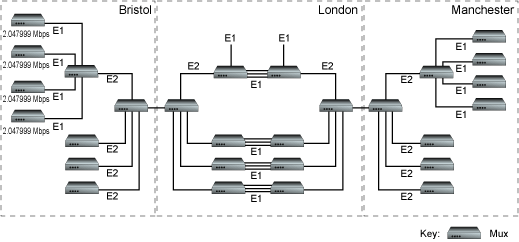G.703 - the basis of all telecommunications networks
G.703, an ITU-T standard that outlines how to interface digital high-speed circuits, has become the basis of all telecommunications networks. Originally, voice channels were multiplexed together by frequency-division multiplexors, which allocated a bandwidth of 3.4 kHz for each voice channel, and a guard tone between each of the mux’s channels minimised crosstalk or interference. This was the first analogue form of multiplexing, but the quality of the voice signal wasn’t superb.
Then came digitisation. With it, 8 bits of telephone voice are sampled at 8000 times a second. Its formula looks like this: 8 x 8000 = 64000 or 64 kbps. This digitising method is called Pulse Code Modulation (PCM) and is defined in detail by the G.711 standard.
Companding
Companding is a process in which a signal’s amplitude range is compressed before transmission then expanded when received. It minimises the number of bits that the PCM must sample in the analogue voice signal before it’s encoded, or “quantised,” in digital form. Companding is available in two encoding varieties: A-law, which is used in Europe, and Mew-law (or µ-Law), common in North America and Japan.
G.703’s physical interface.
G.703 is a specific standard covering physical and electrical characteristics of a digital E1 interface. Under it, data can be travel over balanced (120-ohm) pairs or unbalanced (dual 75-ohm) coax wires; RJ-45 connectors are used for the balanced version, and a pair of BNC connectors is used for the unbalanced interface. Both operate within Layer 1 (the Data-Link Layer) of the seven-layer OSI model.
There are also two types of logical presentation: unstructured and structured. Here’s how they differ:
- Unstructured/Unframed/Clear Channel™ G.703 provides the user with the full 2.048-Mbps bandwidth when run over European E1 lines or 1.544-Mbps bandwidth when supplied via North American T1 lines.
- Structured/Framed G.703 gives a user between 64 kbps and 1.984 Mbps of bandwidth in 64-kbps steps and is also called “framed” service (the G.704 specification details how G.703 operates in frame mode). With structured G.703, you also have the option of running Cyclic Redundancy Check-4 (CRC-4) for bit error monitoring within the first 64K timeslot, which is labelled Timeslot 0 (zero).
Line encoding with G.703.
Line encoding is the method of physically putting all the 1’s and 0’s (that is, the actual data) onto the physical wires. G.703 uses encoding systems, including High-Density Bipolar 3 (HDB3) in Europe and Alternate Mark Inversion (AMI) and Bipolar 8-Zero Substitution (B8ZS) in North America. They all operate on the Transport Layer (Layer 2) of the seven-layer OSI model.
All these line encoding techniques are three-level encoding schemes. In contrast to most data communication protocols in which only two-level schemes typically represent a mark “1” and a space “0,” the three-level system allows an extra change of state, (i.e., a clock to be included). This scheme is used to balance out voltages across wires and, more importantly, encode a clock along with the data structure. The signal is a 1-volt peak-to-peak signal.
Framed vs. unframed services.
As noted earlier, a G.703 service between two sites can be framed or unframed. An unframed service will run at 2.048 Mbps and doesn’t split the data rate in any way. A framed service, however, divides the 2.048-Mbps data stream into 32 64K timeslots. The first timeslot is used not only to initially set up the framing, but also to carry additional information from one end of the line to the other—often when services go international. This leaves 1.984 Mbps for user data.
The type of service provided by a PTT is usually an unframed one. And although it’s possible to order an end-to-end framed service in the rest of Europe, you can’t order one in the U.K.

G.704
If you require several devices to be connected at each end, you’ll have to use multiplexors that support G.704 framing. This is the only way multiplexors can divide the bandwidth into blocks that can be allocated to individual end-user equipment. If the equipment doesn’t support G.704 framing, it can’t divide the bandwidth in a way that makes it suitable for support of multiple devices. But if you only need to support a single end-user device, then support for G.704 framing isn't required, and setup is much easier. In fact, the setup only involves choosing a clock source, whether you want to generate the clock internally (in Master Mode) or receive it across across the network externally (Slave Mode).
Learn more:
IEEE 1284 - The Parallel printer interface.